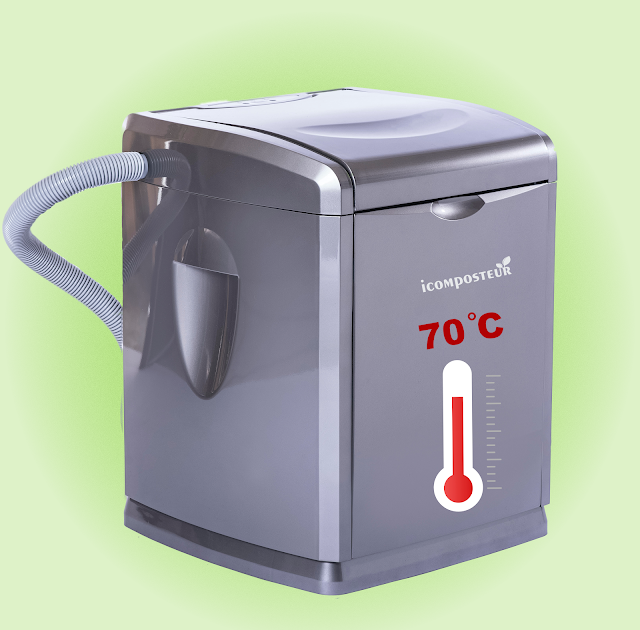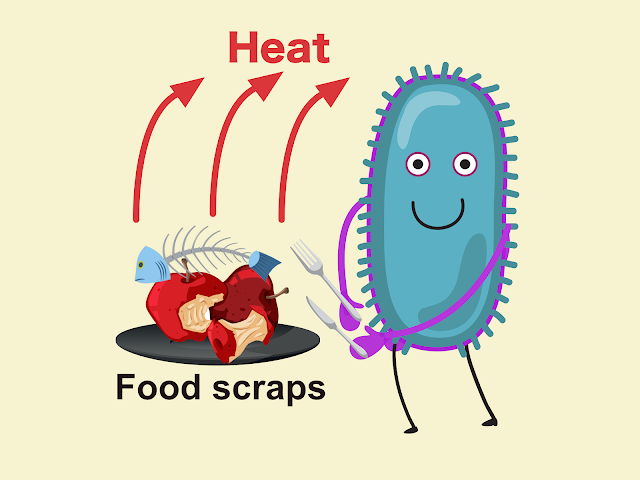Heating takes energy, iComposteur uses the energy smartly. Like most composters, iComposteur has a heating function but NOT for drying food scraps. iComposteur heats the tank to boost the activities of heat-loving bacteria who compost inside.
 |
| There are two types of bacteria who compost for us: Cold-Loving Bacteria and Heat-Loving ones |
We keep 70 ℃ just to make bacteria happy
iComosteur runs a “Berkeley Hot Composting” inside the tank. The compost is cooked up to 70 degree celsius, so the compost will be quickly ready in 2 weeks and pathogens-free, you will get the “Humus” as end product.
iComposteur uses only beneficial bacteria to turn food scraps into humus. The process is called “Composting”. iComposteur doesn't waste any energy in unnecessary drying or grinding the food scraps.
 |
| Heat-loving bacteria compost faster, iComposteur keeps 70℃ just to make them happy |
Only bacteria can compost and they gives out heat while working
In nature, only bacteria and fungi can decompose the plant and animal bodies by using their enzymes. When decomposition is done by bacteria, the long-chain carbon can’t be broken down anymore is “Humus”. Humus contains billions of living bacteria, rich in nitrogen and food for earthworms. The physical structure of humus also improves soil in holding water, air and nutrients.
iComposter is not doing any novelty, it simply runs this process. Inside the tank, bacteria use enzymes to break the food scraps and take the carbon from the food scraps for energy and the nitrogen to build their bodies for reproducing themselves.
When bacteria decompose the food, they are turning mass into energy and the process gives out heat. So the composting pile will get hotter, which favors the thermophilic bacteria.
 |
| When bacteria decompose organism, they give out heat |
Heat-Loving Bacteria is the key to successful composting
Thermophilic bacteria is the heat-loving bacteria. There are two types of bacteria composting for us. The cold-loving (Mesophilic) bacteria work from 10~35 degree Celsius while the heat-loving (Thermophilic) ones work from 40~80 degree Celsius. Thermophilic bacteria work more efficiently than mesophilic bacteria, and that’s why a classic outdoor composting pile has to be 1 cubic meter big for retaining the heat. So if the pile is heated up by the decomposition work that bacteria has done, the heat will self-sustain and get the work done quickly, preferably in 14 days. We will get “humus”. The shorter it takes, the less trouble we will have. For example, the odor, the animals, bugs and complaints.
 |
| Heat-Loving bacteria compost most effectively within the temperature ranging from 40~80℃ |
We use energy to compost, not to make some “Dry Carbon”
iComposteur has a 20 liter- tank, which counts only 2% of a 1 cubic meter pile but it’s insulated. Bacteria decompose food scraps, turning the mass into energy and giving out heat. But when you constantly open and add food scraps in, the heat will lose from the tank. So the heating function of the machine is just to keep the tank around 60~70 degrees Celsius to create the best working condition for thermophilic bacteria. It’s controlled by technology. So that’s why iComposteur is the most energy efficient composter that gives you “humus” but not “dry carbon” at the end.
Many composters dry your food scraps with high temperature to make them look brown, plus grinding them into small powders, so at the end (usually after 24 hrs), food scraps will look more like dirt. Marketing guys call them ”Compost”. But theoretically, these are just “Dry Carbon”. If you burn carbon, it will get brown. Right?




0 Comments